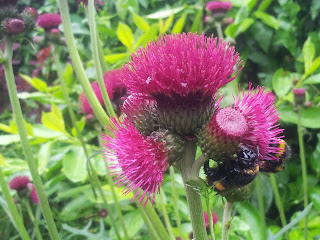I have always wanted to eat wild mushrooms and other than occasional breakfast treats of wild field mushrooms that grew in the meadow alongside our family home, I am bamboozled by the information and the minutiae of detail that helps you differentiate the edible species, which would help me to forage for other types. So when, for the third year running, a ‘giant puffball’ mushroom (Calvatia gigantean) appeared in my garden I was determined to pluck up ‘Bear Grylls’ type courage and sample its lovely white flesh. I was also pleased to have discovered it before the insects had made a meal of it and prior to it reaching maturity when it turns brown and dispersed its spores (up to nine trillion spores, according to one expert).
But first, I had to be sure that I had identified it correctly…
· It is easily identifiable due to its distinct appearance, a large white mass without a stem ü
· Aptly named these mushrooms grow between 10cm and 60cm in diameter ü my specimen was about 5cm a lot smaller than the first one that appeared which was at least 30cm!
· Puff balls lack gills or any other exterior spore-producing features ü
· It is found growing on domestic lawns ü
· The final identification test is to cut it open, it should reveal a dense white flesh with no spores ü
Yippee I had found myself an edible puffball!
I prepared the mushroom by removing the outside skin and cutting it into slices. I simply sautéed it in a little oil a sprinkle of freshly grown parsley a twist of salt and black pepper and a splash of Worcestershire sauce. Served up on a slice of toast made by our local baker Albert (from the Bearwood Pantry) the fungi stayed firm and plump.
There was one more thing to do before I ate this culinary delight… a text message to my husband asking him to call me in one hour exactly just to check I was still alive!
The mushroom did not disappoint and was a scrummy lunch time treat especially so because it was foraged from my own small city garden!
Although I survived this experience please ensure you thoroughly research any mushroom before you consider eating it.
For more information about click here
Follow this link and scroll down to find out about the false giant puffball, a.k.a. the ‘poison goalpost fungus’
very funny!











